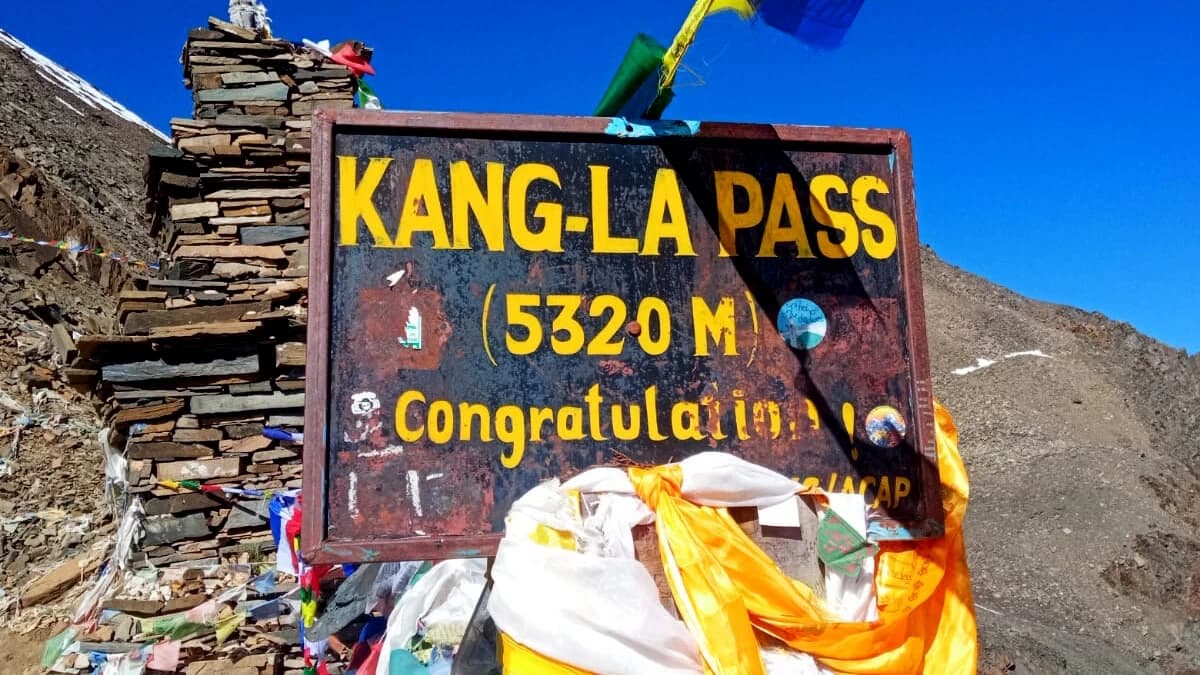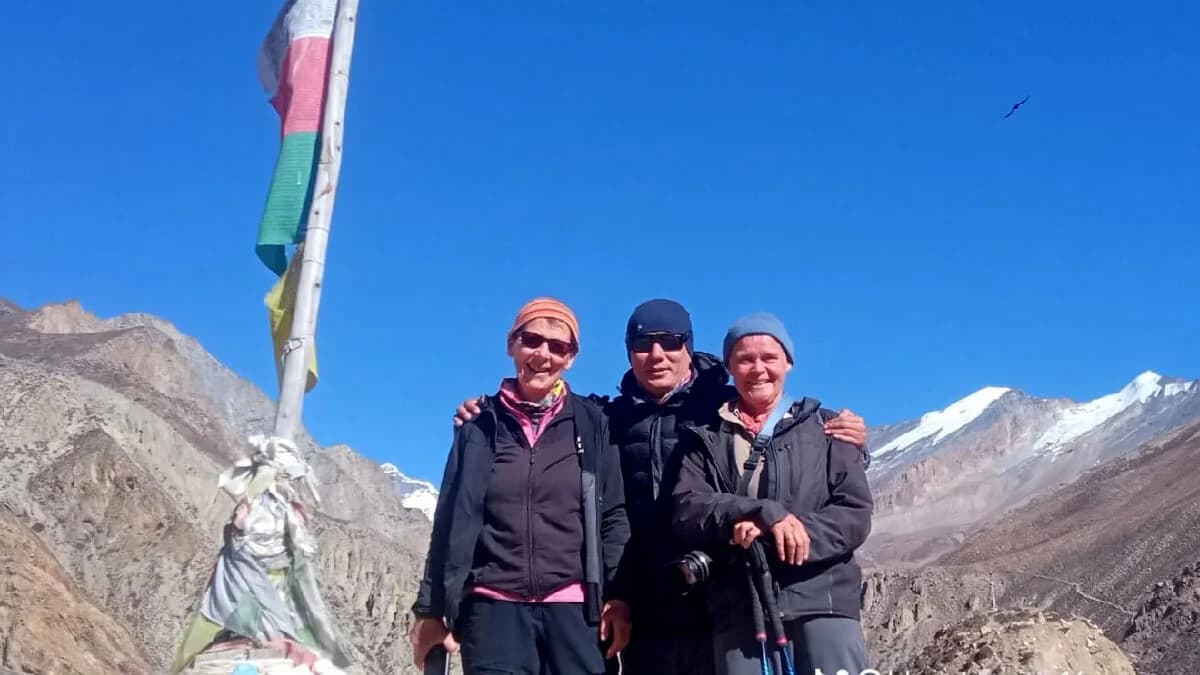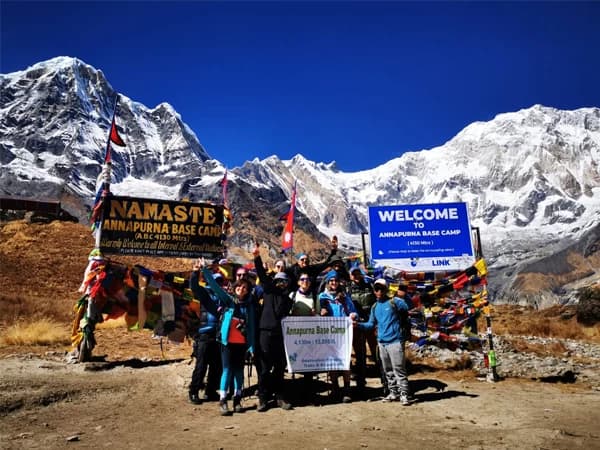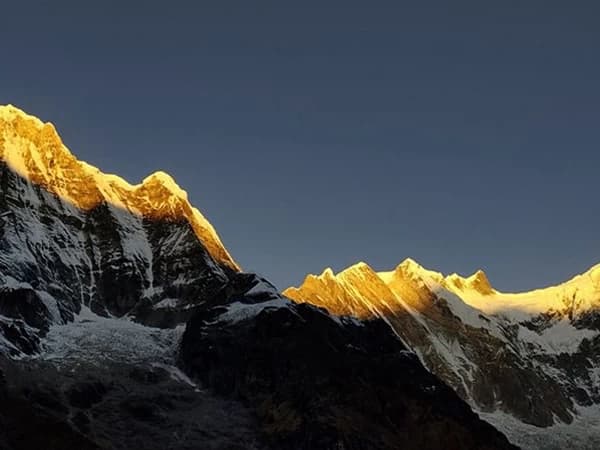Known as one of the best off-beaten trekking trails in Nepal, this Nar Phu Trek navigates through the classic ancient trailhead, between Nepal and Tibet, complemented by suspension bridges, narrow canyons, old Buddhist monasteries, and remote villages in high rock formations that take us to the high pass of Kang La at 5320 meters.
Situated in the rain shadow area, the surrounding landscapes, and the dry Tibetan plateau, seem like an unearthly world, like we are on the planet MARS, or watching an interstellar movie, whereas, with a less frequented trailhead, the serenity of the Himalayas unfolds, with the dry air whispering.
Detailed Overview:
Located in the northern part of the Annapurna region, the Nar Phu Valley Trek leads us on a fascinating adventure around the Tibetan plateau through exotic, rugged terrains where the villages seem to stop in time, straight out of a folk tale, reflecting authentic Tibetan culture. Being out of bounds to trekkers until 2003, the Nar Phu Valley still tends to hold its charisma and rawness, remaining unchanged, as special permits are required to enter this isolated valley, which connects the twin 2 valleys of Nar and Phu in the Manang district.
Throughout this adventure, several mountains such as Mount Manaslu (8163 m), Annapurna I (8091 m), Lamjung Himal, Dhaulagiri Himal, Himlung Himal, and many others, blend with the brown crusty surroundings, ahead, with colorful wild flowers. This 12-day Nar Phu trek includes 2 acclimatization days in Nar and Phu, a visit to Himlung Himal Base Camp, and crossing Kang La Pass (5320m) safely. The trek takes a gradual ascent of only 300 to 400 meters per day, making sure that your body gets used to rising elevation for proceeding to higher elevations, avoiding the possible risk of AMS (Acute Mountain Sickness), and being assisted by the experienced local guides, where the comfort, safety, and best coverage of highlighted spots are assured.
Starting from an elevation of 1360 meters above Kathmandu, with a drive to Dharapani (1860 m), via Besishar, and following the trailhead, navigating through the major key villages, Koto (2600 m), Meta (3560 m), Phu at 4252, and Nar (4150 m), and then crossing the high pass of Kang La. Descending from the top of the Kang La Pass, we will take a downhill walk to Ngawal and then, Pisang, and finally conclude our trek with a drive back to Kathmandu.
At every step, along the Nar Phu Valley Trek route, we'll be greeted by Tibetan locals with red cheeks, gracefully smiling, providing warmth on our long hiking day. The yak pastures and blue sheep grazing on the terraced fields, the Buddhist gompas surrounded by colorful prayer flags, mani walls, and chortens. Against the backdrop of breathtaking mountains such as Annapurna I, Manaslu, and Tilicho Peak, along with over 20 other peaks, lies a heavenly vicinity that transports us to an ancient era far away from the modern world.
For those who want to feel the lively experience of the culture and tradition of Tibetan locals by navigating through the off-beaten path, rocky terrains, with a little bit of a touch of adventure, this 12-Day Nar Phu Valley Trekking is perfect for you, where serenity and stunning, unblemished views accompany you every step!
Major Highlights of the Nar Phu Trek
- Feel a sense of accomplishment by crossing the high passes, of Kang La Pass at 5360 meters
- Walk through the remote, less crowded trekking route, one of the pristine trailheads, surrounded by the Tibetan dry plateau, deep canyons, and highly towering peaks
- Get a lively experience of Tibetan culture and tradition, residing at such a high altitude of over 4000 meters, at Meta, Koto, Nar, and Phu
- Befriend several mountains such as Dhaulagiri, Annapurna, Manaslu, Nilgiri, and not to forget Tilicho Peak
- Reach the Himlung Himal Base Camp- 4900 m, unraveling the alpine glaciers
- Witness Himalayan yaks and blue sheep grazing beautifully on the terraced fields
- A spiritual visit to an ancient gompa, such as Tashi Lamang Gompa, surrounded by mani walls, chortens, and prayer flags
- Gaze at the perfect, unmatched fusion of the high altitude dry brown landscapes, blending with the lush green verdant forest with thriving red rhododendrons, and white orchids
- Unveil the mysterious, isolated village of Phu for a whole day, known for its unchanged culture, preserved arts, and architecture dating back centuries
What makes the 12-day Nar Phu Valley Trek a must-do adventure in Nepal?
Being located in one of the isolated sections of Nepal within the Annapurna region, the twin valley of Nar and Phu is a hidden treasure that is surrounded by diverse landscapes and rich, untouched Tibetan culture, with a limited footprint from the adventure seekers, as special permits are essential to enter this valley - hence, not everyone can get access here easily. It would be seriously no debate to consider Nar Phu valley as the top listed off beaten adventures in Nepal, which visits several Tibetan villages, through the rugged terrains and Tibetan plateau highlands like Mars, totally out of this world. While it might sound like an exaggeration, here are the top 5 reasons to undertake this adventure, which make you believe that heaven does exist here in the land of the Himalayas:
Experience the off-beaten adventure and wilderness
Even though the Nar Phu Trek is considered one of the emerging treasures among the thrill seekers who love to explore the wonders of pristine landscapes, as compared to other expeditions like Annapurna Base Camp and EBC Trek, Nar Phu Valley is a newly opened route, just initiated in 2003 AD. Touching both the iconic regions of Manaslu and Annapurna, it is the less-traveled and less-frequented trail, due to its remote route and unfacilitated trailhead, where the ancient villages and the pathways, alleys, and locals preserving their culture are still in the ancient era.
While many famous treks in Nepal are being rapidly spoiled by the modern infrastructure and equipped with luxury city alike aminities, Nar and Phu valley remains the same from century to century, falling under the restricted remote area of Nepal. Imagine just settling at the local tea houses, where Tibetan locals call their home, and being savoured with the ancient culture of untamed original Tibetans, offering a feel of tranquility far away from the crowded modern world, well, this is Nar Phu Valley Trek for you!
Immerse yourselves in the local hamlets, and gaze at animal herding process, agricultural farming activities, thangka painting woolings, and wake up with the sound of cows and yaks, and end the night with the chirping sound of the Himalayan birds and indulging in the local foods, made out of love - by opting one of the most precious hidden gem of Nar Phu.
Gaze at the Sparkling Thundering Mountains in Each Stride
Touching the highlands of the world's eighth and tenth highest mountains in the world - Manaslu and Annapurna- this trek to Nar Phu Valley offers the best panoramic vista of the Himalayan range with each stride. From the marvelous transition of the lush green valley, villages, rugged terrains, rocky sections, to snowy, frosty peaks, the diverse topography will amusingly surprise you. Throughout the odyssey, it rewards you with a 360-degree view of Manaslu (8163 m), Annapurna (8091 m), Khangsar Kang (7386 m), stretching to Gangapurna (7476 m), Himlung (7128 m), and Tilicho at 7136 meters, and their close-up view from the top of the pass.
Cross the Thrilling Kang La Pass at 5320 meters
One of the most iconic, exceeding the elevation of 5000 meters, marks to be the Kang La Pass, where the journey itself is not less than a thrill or a roller coaster climb to the pinnacle, passing through a distinct variety of terrains, with multiple ascents and descents, demanding a high level of fitness. While the uphill climb begins from the morning at 4:00 AM, which is demanding, it requires 8-10 hours of continuous hiking, after reaching the top pinnacle, unravels the captivating sunrise view over the Annapurna ranges, including Annapurna I, II, Gangapurna, Tilicho Peak, at it's 360 degree panoramic form, which is why this view point, also, listed at the best annapurna view points. Apart from the views, it also stands out to be an adrenaline-boasting adventure, giving you a sense of accomplishment after the hardship, boosting your self-confidence, and resilience.
Visit ancient monasteries and Tibetan culture in Nar and Phu
One of the major highlights of this Nar Phu Valley Trekking is the unchanged cultural exploration of the Tibetan settlers, being highly influenced by the Bon religion - the oldest Tibetan Buddhist tradition. While many cultures have been highly influenced by modernization, the locals have been preserving their cultures from generation to generation, and the living proof is the many walls, chortens, red shrines, gompas, and the colorful Buddhist Tibetan prayer flags dotted here.
The major villages of Nar and Phu demonstrate their culture in the form of stone houses, with distinct, meaningful architecture, carved with wooden doors and windows, and while settling down here, you can witness their traditional lifestyle through animal herding and ancient-style agricultural farming. Amongst all, this valley also celebrates the colorful festival of Mani Rimdu, the oldest functioning monastery of Nepal, dating back 500 years. Besides, this 12-day Nar Phu Trek also visits other monasteries, including the Lhogaon Monastery at Dharmsala, and Phu at the Ghompa valley, showcasing a deeper insight into the Tibetan Buddhist historic culture.
Side Trip to Himlung Himal Base Camp near Phu Gaon
What makes our 12-day Nar Phu Valley Trekking itinerary stand out is the acclimatization days set for two days, at the major village of Nar and Phu, where we will explore the highlighted Tibetan cultures and livelihood.
During the acclimatization day, at Phu gaon, we will engage in a side trip excursion to Himlung Himal Base Camp that soars between the elevations of 4890 meters to 4920 meters, which unravels the beauty of the highlands, showcasing the dramatic glacial landscapes and panoramic close-up view of Himlung Himal at 7128 meters, becoming your reward after a hard endeavor, and boasting your energy, for further trek, on the remaining days. This side trip doesn't include any technical or demanding experiences; in fact, it is an intellectual way to acclimate your body before hitting the higher elevation further, showing a unique insight into the mountains and the alpine navigation route.
While many of us might perceive that this trek to Nar Phu valley is all about highly towering mountains and varied landscapes, the rich, diverse cultural mosaic of Buddhist spirituality, and the untamed lifestyle of locals leave a lifetime mark on your heart forever.
Nar Phu Valley Trekking Distance
The total distance of the Nar Phu Trek highly varies depending on the route you are opting for, the side trips, or the combined itineraries, included or not, within the itinerary, whereas, in general, the route covers 82 to 102 kilometers of trekking distance in total. If you are considering combining this trip with the Annapurna Circuit Trail, then the trekking distance gets more extended by 50 to 62 kilometers, whereas this trek solely focuses on covering the Nar Phu route, within 12 days, starting from Kathmandu (1360 m), and reachs to the highest elevation at Kang La Pass (5320 meters), with two acclimatization days included.
Meanwhile, the walking trekking trails mark somewhere between 8 to 12 kilometers per day, with 5 to 6 hours of hiking, passing through distinct kinds of terrains starting from Dharapani at 1860 meters, from verdant forest, to rugged, remote, isolated sections, to dry Tibetan plateau, surroundings, and alpine meadows, and ascent to high passes. Throughout this trip, it passes through several key stopping points of Koto (2600 m), Meta (3560 m), Phu (4250 m), and Nar (4138 m), before crossing the high elevation. Whereas, two acclimatization days are set at the major villages of Nar and Phu, which include the side trips to Himlung Himal Base Camp (4842 meters) from Phu gaon, and then, explore the culturally rich traditional Nar on the leisure day.
The longest trailhead that you will come across stands out while crossing over the Kang La Pass (5320 m), for a straight 8 to 10 hours, which demands navigation through several steep sections, up and downhill walks, whereas, the shortest day, is the acclimatization (rest day), at Phu and Nar, that demands only 3 to 4 hours of hike (exploration trip). Our 12-day Nar Phu Valley Trekking itinerary includes a gradual ascent of 300 to 400 meters per day, without navigating beyond the limitation, so that your body gets used to the rising elevation gradually, before proceeding with the trek further to higher elevation, minimizing the risk of AMS (Acute Mountain Sickness).
Note: This itinerary covers the trekking route for a straight 10 days, where 2 days have been set as an arrival and preparation day for this trek, before beginning the trip, as a leisure time for packing, arranging permits, and experience the Seven UNSECPO Heritage Tour in Kathmandu, Bhaktapur and Patan, if you don't want one, and planning to start the trek, from Kathmandu straightly, without having any arrival dates included, then the itinerary can be set accordingly.
Transportation to Reach the Starting Point of the Trailhead
The transportation used to and from Nar Phu Valley Trailhead follows the roadway, covering a driving 6-7 hours, via tourist bus, to reach Besisahar, as per the itinerary, and then take a sharing jeep towards Dharapani, from where the walking trail gets started. Then, the trek ends with touching the village of Pisang, which is also marks to be the route to the Annapurna Circuit.
From Pisang, we will take a drive to Besisahar, via private 4WD jeep, and then take a tourist bus ride towards Kathmandu, or Pokhara, wherever you want to end the trip. While the transportation costs are included in our package, if you want more comfort or travel privately, with your choices of stopping points, for a tea break, leisure exploration en route, then you can upgrade the sharing jeep, or tourist bus to a private jeep sharing which accommodates 5 passengers, well, if you have a group, then, that's a great deal, to share the cost. Whereas, if you are trekking solo to Nar Phu, then the private jeep can be on the expensive side, costing approximately USD 230 to USD 270 per private 4WD jeep; however, the sharing jeep cost to reach the trailhead is included in our package.
Nar Phu Valley Trek Cost for 2026 and 2027
Our 12-day Nar Phu Valley Trekking cost ranges from $ 1049 and goes up to $ 1299, per head, which highly depends on the number of hikers that your group holds, as the higher the count of hikers, the group has, the pricing gets minimized accordingly. Meanwhile, the trek to Nar Phu costs range from USD 1400 and go up to USD 1500, depending on several factors, like distance covered, no. of days (duration of the trip), solo or group trip, and the kind of transportation you are seeking to reach the trailhead.
Whereas, for a private solo trek, the price stands out to be USD 1299, per head, which covers all the requirements for the trip, from the basic facilities like, meals (3 times Breakfast, Lunch and Dinner), accommodations, transportation to reach the point, to the arrangements of experienced licensed guide, paperwok, regarding the required permits with other additional complimentary services as well.
Here are the costs of the trip, especially customized for the years 2026 and 2027, that we at Destination Himalaya Treks offer, with a group discount:
| No. of Hikers | Standard Price (In USD) |
| 1 | 1299 per head |
| 2-3 | 1149 per head |
| 4-5 | 1099 per head |
| 6-10 | 1049 per head |
Why venture out to this Himalayan Adventure with Destination Himalaya Treks and Expedition?
Trekking in Nepal is one kind of adventure that lets you unravel the distinct landscapes, unique tapestry culture, and snowcapped towering mountains thundering at the clear skies. There's no doubt, when it comes to either tours, treks, or even thrilling adventure, or the cultural exploration trips, Nepal is one of the best countries, with many best places to visit, for spiritual, nature connecting, or exploration, with more than 6000 peaks, that too, eight-thousander mountains residing just here in the small continent of Asia.
We at Destination Himalaya Treks and Expedition have been serving more than thousands of hikers to every corner, from hikers across the globe, for almost 3 decades now, hitting the milestone of 20+ years, located in the major hub of tourism in Nepal, Thamel - Kathmandu. We highly believe in 3'S, Safety, Sustanibility and Secured trip, where your adventure, becomes more than, just reaching to the destination, but also, every minutes, seconds, passed by makes you feel, like you are at an unearthy world, far from busy scheduled life, where you get to celebrate serene time, with our finely customized 12 Days Nar Phu Valley Trek itinerary, which is bestly customized, including all the highlighted spots to visit, and properly set gradual ascend with 2 acclimatization days, for a safe and sound trip.
Our guides are licensed, experienced, and medically trained and equipped, who will assist you through a safe trekking trail, and are locals as well collecting experience with more than 10+ years, and if any unfortunate situations occur, then they become your first-hand medical emergency assistance, like a superhero, in such an isolated trekking region. On the other hand, we also believe in transparency, where our cost isn't hidden; whatever is shown on the website will be provided to you, without any hidden cost policies, which you can check in the cost details section at the top bar. In fact, to make your trip even more comfortable, we provide additional benefits as well:
- 2 Days Free staycation after the trip ends, at a comfortable standard at our own Hotel Bihani with no additional cost
- Short Detailed Briefing regarding the trek, before the booking, with expert guidance
- Free Airport Shuttle from and to the International Airport via private vehicle to the hotel
- Guided Sightseeing Tour at UNESCO World Heritage Sites
- 24-hour communication at Viber, Message, direct call, WhatsApp while on the trail, via +977 9851016814 or mail at info@destinationhimalayatreks.com
- Customization of the trek as per your budget and itinerary
- Trip Completion certificate after the trek is completed
- Best experienced local guide, with more than 10+ years, being medically equipped and safe navigation
- All the logistics included in our package, from meals, accommodations, permits, guides, porters and transportation
- Easy Booking Process with no hidden cost
- Trekking Company T-shirt, Cap and even Duffle Bag or Sleeping bag (if required)
- Crampons (if it's required) to cross the pass






